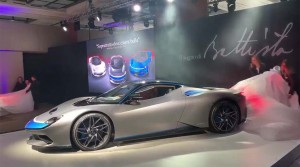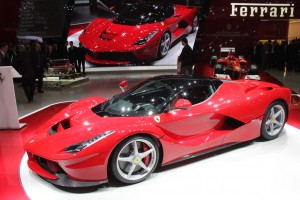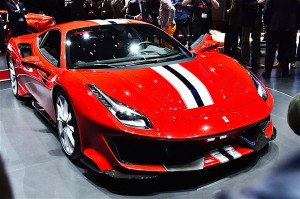It’s been a while since Ferrari first dropped the hint that it would add a new hybrid to its line-up and now, according to CEO Louis Camilleri, we’ll be getting to see it before the end of this month.
The hybrid will be one of five new models coming from the Maranello-based manufacturer, said the chief executive, and there are some signs more than one of these products will rely on an electrified boost to performance. But that should surprise fewer and fewer Ferrari fans considering the broad push towards battery propulsion in the supercar and hypercar segments.
We’re hearing plenty of rumors about the hybrid coming this month, including the comment Camilleri dropped during a conference call to discuss the brand’s first-quarter earnings. According to the chief executive, “It will be a top-of-the-line hybrid with supercar performance and a true beauty.”
(To see more about Ferrari’s new F8 Tributo, Click Here.)
It won’t be Ferrari’s first hybrid, of course. One only has to look back as far as 2013, when the Italian automaker unveiled the La Ferrari at the Geneva Motor Show. Capable of launching from 0 to 100 kmh, or 62.5 mph, in less than 3 seconds, and 186 mph in 15 seconds, it relied on a Formula One-derived HY-KERS, or hybrid kinetic energy recovery system, paired with a conventional, 6.3-liter non-turbo V-12.
Luca di Montezemelo, then Ferrari president, described the new model as the “maximum expression of what defines our company….all the capabilities of our know-how,” adding that the LaFerrari “represents the future” for one of the world’s most respected sports car manufacturers.
While the new model isn’t expected to fill the top rank on the Ferrari ladder, it is believed to be capable of delivering more power than the current 488 Pista’s 711 horsepower. And, thanks to the all but instant torque generated by an electric motor, it will likely provide a neck-snapping launch feel.
All that said, “It’s not a 488 replacement, per se,” Camilleri said during a conference call responding to an industry analyst’s question.
As to what sort of hybrid system Ferrari will use this time, that is still a matter of speculation, but a story in Automotive News this past February indicated the new model will forego the V-12 found in La Ferrari in favor of a V-8. The decision, according to Ferrari sources, reflects the fact that the smaller engine is needed to help meet increasingly stringent global mileage and emissions rules.
What’s clear is that Ferrari is not sitting back as the rest of the industry starts to embrace electrification. Camilleri told Automotive News that 60% of the automaker’s line-up will offer hybrid drivelines, at least as an option, by 2022.

The Pinininfarina Battista made its debut in Geneva this year and increases the focus on electric supercars.
Separately, the executive told CNET’s Roadshow at Geneva that Ferrari is “studying” a fully electrified model, among other things looking at challenges like weight and sound, “but right now, we are not taking any decision.”
But it will have to move soon and could have something in production by 2022, according to several analysts.
The why is simple: despite the obvious drawbacks like weight, range and the lack of a classic Ferrari engine note, fully electric vehicles can be phenomenally powerful and fast. And, since the latest generation of EV design moves batteries and motors below the floorboards of a skateboard-like platform, they can turn weight into something of an advantage in the form of an extremely low center of gravity.
Michael Leiters, Ferrari’s tech chief, provided another argument for electrification – in one form or another – in an interview with Top Gear. “We’re at the limit of the performance,” he acknowledged, for conventional, internal combustion engines.
(Click Here to check out the 1,900 hp, all-electric Pininfarina Battista.)
If all that isn’t convincing enough, consider the list of competitors who are going all-electric, including Pininfarina which debuted its Battista in Geneva this year, the 1,900-horsepower drivetrain expected to deliver a 0 to 60 launch in less than 2 seconds. It’s difficult to find a single supercar manufacturer not giving serious thought to an all-electric product today, never mind plug-ins and more conventional hybrids.
The final reason? Those increasingly tough government mandates. China is putting the squeeze on the internal combustion engine through the New Energy Vehicle mandate passed in late 2017. And it is one of a number of countries considering outright bans on gas and diesel engines. The UK, for one, may move that way by 2035 and Norway has already scheduled a phase-down for the internal combustion engine. Some cities, including London and Paris, are looking at outright bans of all but zero-emissions vehicles – or at least those that can switch to battery power.
(It’s official: mid-engine, Ferrari-challenging Corvette C8 making its debut in mid-July. Click Here for more.)


